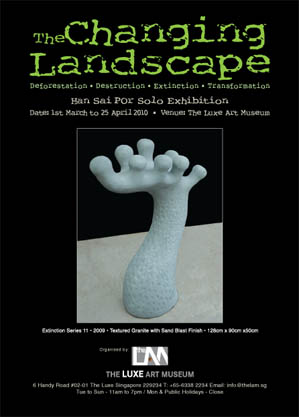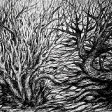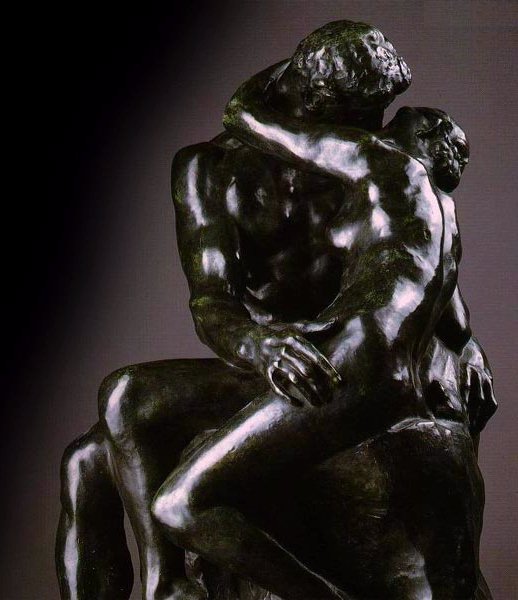Sunday, August 29, 2010
Rodin: Exhibitions. My work! In public!
Saturday, August 28, 2010
The Changing Landscape - Deforestation. Destruction. Extinction. Transformation

Hi everyone, I just had an exhibition this year (but unfortunately it was over so you can't go). As the name suggested, it's about the environment, about Singapore, about the place I live on. The series of sculptures were based on four topics, namely 'deforestation', 'destruction', 'extinction' and 'transformation'.
The topic wasn't new and unprecedented. For many years my positions have been stemming from a life-long involvement in nature as a vital force and as a gragual transforming process. This in turn, influences my choice of material and preferred technique of sculpting. Stone has always been my favourate material. The process of chiselling, drilling and hammering allows me to discover a lot more new things beneath the surface of material and provides me with the energy to continue my life as a sculptor.
Ok, back to the original topic. I care a lot about nature and thus I'm worried for it as well, especially when some not so good things are happening right in Singapore. An essay by T.K.Sabapathy (I don't know who he is) has well summarised my feeling:
"Under the government's green policies, Singapore has been reconstructed as a garden city. The messy natural landscape- the rainforest- has been replaced by a man-made landscape... However, the substitution of the natural in recent years has, according to Sai Por and for all of us, led to profound estrangements and severe dislocations."
Hence in my sculptures, I signify these de-natured, divorce consequences of substituting nature with artifice.
For example,
 The clearing away of the "messy rainforest" to make way for a beautiful but artificial landscape "garden".
The clearing away of the "messy rainforest" to make way for a beautiful but artificial landscape "garden". Garden. Just think of this word.
Garden. Just think of this word.Rodin: Dancers and Drawing. Unfinished?
Well, wonder no further.
(Get it? "Wonder", "wander"...)
But first a photo of myself.

Here I am drawing some Cambodian dancers in 1906. They were the royal dancers of the King of Cambodia (still a French protectorate at the time; ah how times have changed!) Even from this photograph above you can see that they have a curious - yes, curious, for the dancers were so different from what we were used to in France! - but graceful air about them. They had the supple movements and attitude one expects to see from a dancer, enhanced by how exotic they were. The elegant movement of dance has fascinated me throughout my life, and you can imagine how happy I was when I heard about them.
I remember it well. There were more than 40 of them and the first time I saw them was when I was invited to a garden party at a gala performance held at Pre Catalan in the Bois do Boulogne. One of my contemporaries, P.B. Gheusi, described me as going into "ecstasies" over them, "whose immaterial silhouettes [I] drew with infinite love". I should think that he is quite right! I spent countless hours drawing them at the gardens of the rue Malakoff villa where they stayed, and took the chance to sketch some portraits of the King of Cambodia (Sisowath) himself.
The dancers next had an appointment at the Colonial Exhibition at Marseille. Of course, I wanted to study them more closely, so I went to Marseille as well. There is an interesting backstory behind the drawings of that day as well.
“To study them more closely I followed them to Marseille. I arrived on a Sunday and went to the Villa des Glycines [to see the dancers]. I wanted to get my impressions on paper, but since all the artists' materials shops were closed I was obliged to go to a grocer and ask him to sell me wrapping paper on which to draw. The paper has since taken on the very beautiful gray tint and pearly quality of antique Japanese silks. I draw them with a pencil in my hand and the paper on my knees, enchanted by the beauty and character of their choric dances. The friezes of Angkor were coming to life before my very eyes... I loved these Cambodian girls so much that I didn't know how to express my gratitude for the royal honor they had shown me in dancing and posing for me. I went to the Nouvelles Galeries to buy a basket of toys for them, and these divine children who dance for the gods hardly knew how to repay me for the happiness I had given them. They even talked about taking me with them.”
Ah, what a wonderful memory indeed. Here are some of the drawings of the dancers I produced. Their interesting style is perhaps in part because I never let my eyes leave the subject while I am drawing it:


Sadly the public has (had, anyway) sometimes accused my drawings of being "unfinished" just because they are more expressive than what they are used to. Pah! The attitude and gesture of the subject is of utmost importance. I would rather do a million of these "unfinished" drawings than bog down a subject's inherent brilliance and spontaniety by "finishing" it.

Here is one of my "unfinished" drawings. What do you think of it?
P.S. You can see more of them at the Musee Rodin.

Rodin: The Kiss. Unison vs. Isolation.

It's subject matter is fairly obvious: A couple locked in a kiss. The forms are, as always with my work, naturalistic and expressive, conveying the depth of the intense emotions the lovers feel. But now time for a little backstory. Wikipedia provides a nice summary of the story (if you let me go into it, I would never manage to talk about the work):
The sculpture, The Kiss, was originally titled Francesca da Rimini, as it depicts the 13th-century Italian noblewoman immortalised in Dante's Inferno (Circle 2, Canto 5) who falls in love with her husband Giovanni Malatesta's younger brother Paolo. Having fallen in love while reading the story of Lancelot and Guinevere, the couple are discovered and killed by Francesca's husband. In the sculpture, the book can be seen in Paolo's hand. The lovers lips do not actually touch in the sculpture to suggest that they were interrupted and met their demise without their lips ever having touched.I fell that in a way, this sculpture is a homage to women everywhere. Look at the lovers: the female is equal to the man, neither of less weight than the other in the perfect harmony of their love. Yes, women can be equal to men. So stop complaining that you don't get enough respect in artwork.
It's not one of my favorite works, though, to be honest. Recall what I said about it in earlier days:
The embrace of The Kiss is undoubtedly very attractive, but I have found nothing in this group. It is a theme frequently treated in the academic tradition, a subject complete in itself and artificially isolated from the world surrounding it; it is a big ornament sculpted according to the usual formula and which focuses attention on the two personages instead of opening up wide horizons to daydreams.I based it off one of the small figure groups from The Gates of Hell.* Remember how each figure group was seemingly isolated from the rest, never to achieve true unity with its surroundings? This was achieved by the use of pre-made parts and piecing them together (in a way) with The Gates of Hell. Here I would suppose the figures are too lost in their own world to pay attention to the space around them. It's an interesting conflict - or maybe non-conflict and complete non-interest - between the "inner space" of our emotions and the "outer world" around us. But still, can't you just feel the sheer delight and love of the two partners emanating from the sculpture? That's what someone said to me when he saw it. I'm glad that my work inspires such responses in viewers. Does it in you?
*Well, it was intended for use in The Gates of Hell at first. I eventually replaced them with another couple.
Here's another version in white marble.


Wednesday, August 18, 2010
Rodin: The Gates of Hell. Activity without accomplishment.
 This is The Gates of Hell. Pleasant image, isn't it. Do you feel a sense of fragmentation in this work? Do you know why?
This is The Gates of Hell. Pleasant image, isn't it. Do you feel a sense of fragmentation in this work? Do you know why?I made each of the figures on the Gates separately. Some of them are even what other sculptors of my day would consider "incomplete". The result of this is that the figures feel like they were patched together. Even though they are all together in the same work, there is no true unison between them (because I created each one separately), leaving them only to grasp desperately at each other without ever being able to attain mutuality.
Do you also notice that many of the figures (especially on the two sides of the Gates) are similar to one another? When I make my sculptures, I make "spare parts" like hands and torsos, which I can then put together to complete a figure. In this work, my use of figures with identical torsos and similar poses* helps to show the idea that despite all the frenzy and activity going on, there is no real change that has happened. The Gates of Hell indeed - all action but not accomplishing anything, without an end in sight. What a wretched existence!
* But don't you find it interesting that the same body parts, arranged in different combinations and poses, can provide such a great variety of figures? I feel as though this method of working makes the range of meaning my work can show so much wider.
Sunday, August 15, 2010
Growth My Concern
 I made this series in 1985...25 years ago!(Oh, time is cruel)
I made this series in 1985...25 years ago!(Oh, time is cruel)
You might wonder why these five pear-shaped marble sculptres are associated with growth. I understand the idea of growth is hard to be expressed in any specific forms or there are simply too many ways to illustrate it. Then, why not use abstract forms to illustrate abstract idea ?
To catch the essence of an idea, you have to reduce the object to its very basic form. I learn this from Brancusi, the pioneer of abstract sculpture.
However, if you have seen my later works, you should notice that my style is changing over the years. Every artist will eventually develop her own unique style, isn't that so? I thought simplicity its own was no longer sufficient to express my idea, so I decided to add in more details, like this one below:
 This one is named "Seeds", made in 2006. Not only they look like a seed, I also put them in a natural environment. Lying in grass, they seem to have a force inside the layer of brown skin, or a soul. That is growth.
This one is named "Seeds", made in 2006. Not only they look like a seed, I also put them in a natural environment. Lying in grass, they seem to have a force inside the layer of brown skin, or a soul. That is growth.Rodin: Nature. Spontaniety. The essence of things.
I submit only to the requirements of nature. Handling the models as dolls, my colleagues are in danger of creating artificial, dead works. I catch the beating life which I see in nature, but I do not force it in any way....I want to reproduce in art only that which is free. I submit to nature in everything...I am very proud of being slavishly true to life.I believe nature is dynamic, spontaneous, and that is why when I sculpt I do not pose my models. No, I let them walk around my studio, I let them do whatever they want, until they chance upon something which captures the essence of their natures, and then I get to work. Every one of my works must be filled with the model's true nature, even if it is "imperfect". The artistic impulse is the key.
Recall my advice to other sculptors after I became famous:
Your mind has to understand every surface as the outer limit of a volume pressing against it. Imagine shape as something directed towards you. All life has its origin in a centre, then it blosoms and unfolds outward from within. Exactly this way one can sense a mighty inner impulse in every beautiful sculpture. That is the secret of antique Art.
(Auguste Rodin, "Testament", quoted in Gsell, German edition, Diogenes, Zürich, p. 8, English translation)
Saturday, August 14, 2010
Rodin: Struggle. Sadness. Deep emotions paralleled in my art.
Do you know why?

That is me. Dashing, I know. It's also a hint as to why my works are so emotionally resonant. The emotions I experienced in my life were tumultuous, as you can see from my great expression in the photo.
When I was young I was shy and suffered from myopia. I took art classes at the École Impériale de Dessin. It was then that I found clay and discovered sculpting, my true love! I was really good and had won two prizes for drawing and modelling by the time I was 17, but the prestigious École des Beaux-Arts refused me. THREE TIMES.

(My father.) My family wasn't particularly rich, so in 1858 I started putting my talent to commercial use and worked on public projects like statues and ornamental sculptures. I was very busy, working in the day and doing my own art at night. In 1862 my sister suddenly died. It was one of the most painfully vivid experiences of my life. I tried to seek solace in a the Catholic Order of the Holy Sacrament, but Father Eymard there encouraged me to resume doing my art to help me heal. In the end I left the monastery and became a sculptor.


